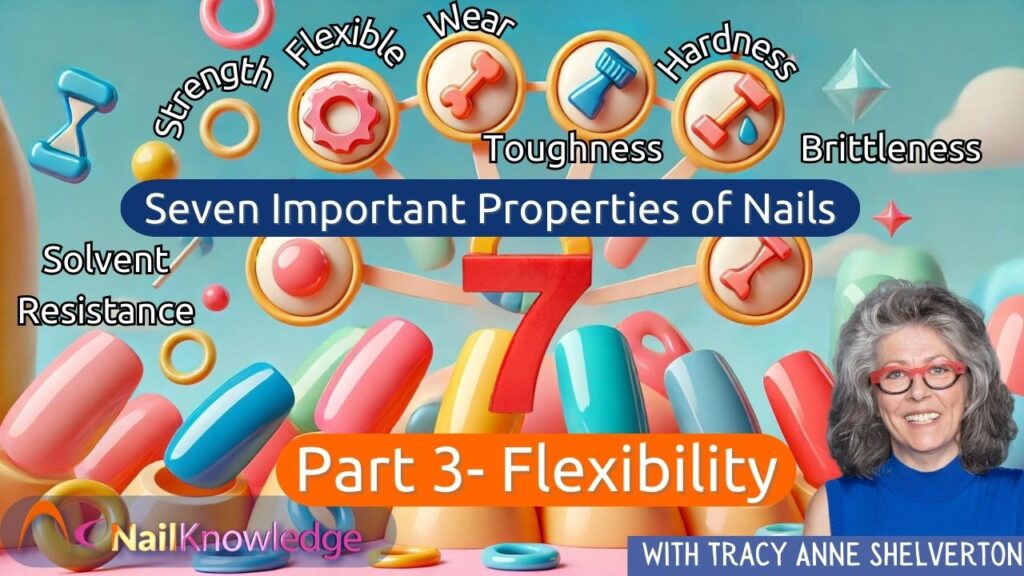Flexibilidad de las uñas: La tercera propiedad clave de las uñas naturales y artificiales
In this third part of our series on the key properties of natural and artificial nails, we move from strength and hardness to explore flexibility. As we have already discussed, strength is the ability of a material to resist breaking under pressure, while hardness determines how well a material can resist surface scratching or denting. Flexibility, however, is the capacity of a material to bend without breaking. Just as Confucius said, “The green reed which bends in the wind is stronger than the mighty oak which breaks in a storm,” flexibility is essential for nails to absorb impact and avoid damage. This balance between hardness and flexibility is what keeps nails resilient in everyday activities.
¿Qué es la flexibilidad y por qué es importante?
La flexibilidad permite que una sustancia se doble y absorba la fuerza sin agrietarse ni romperse. Esto es especialmente importante en el caso de las uñas, tanto naturales como artificiales, ya que evita que se rompan bajo presión. Las placas ungueales normales y sanas tienen un buen grado de flexibilidad, lo que significa que se doblan en lugar de romperse cuando están sometidas a presión. Por el contrario, las uñas inflexibles son más propensas a agrietarse y romperse, lo que puede provocar molestias y daños en la piel. lecho ungueal.
Hay varios factores que influyen en la flexibilidad de las uñas, como la edad, la dieta, el estado general de salud y la exposición a productos químicos agresivos o a las condiciones ambientales. Por ejemplo, la exposición prolongada o repetida a productos de limpieza, agua, tierra de jardín y abono y/o disolventes puede fragilizar las placas ungueales y reducir su flexibilidad, además de hacerlas propensas a las infecciones. Los profesionales del cuidado de las uñas deben reconocer este equilibrio y seleccionar tratamientos o sistemas de clavos that best suit the flexibility of their clients’ nails but also their clients habits, work and hobbies.
Dureza y flexibilidad de las uñas: Encontrar el equilibrio
While hardness and flexibility are often confused, they are distinct properties. Nail hardness refers to a nail’s resistance to surface damage like scratching or denting, while flexibility determines how well a nail can bend without breaking. A healthy nail needs both hardness and flexibility. Nails that are too hard may resist (surface) scratching but are at a greater risk of cracking or breaking under pressure. Conversely, overly flexible nails can become weak and prone to breakage.
For artificial nails, striking this balance is equally important. For example, cyanoacrylate-based systems, like fiberglass wraps, are highly flexible. However, they may not reinforce overly flexible natural nails and can lead to lifting, cracking or breakage. In contrast, systems that use monomer liquid and polymer powder, or UV gels, can provide greater strength and protection (depending on the ingredients) for weaker, more flexible nails.
Por qué demasiada flexibilidad puede ser un problema
While flexibility is necessary, too much of it can also lead to issues. Nails that are excessively flexible can become fragile and prone to damage. A prime example is the use of methyl methacrylate monomer (MMA) in artificial nails, which creates coatings that are too rigid and not flexible enough. This lack of flexibility causes the nail coating to resist bending with the natural nail, leading to a greater risk of severe nail bed damage.
For healthy nails, whether natural or artificial, it’s essential to maintain a degree of flexibility that allows the nail to bend without breaking, while still providing enough strength to withstand daily activities. Products that promote a balance of strength and flexibility matched to the condition of the natural nail are key to ensuring that nails remain healthy, durable, and aesthetically pleasing.
Mantener la flexibilidad de las uñas naturales y artificiales
To keep nails flexible, it is important to avoid overexposure to harsh chemicals and solvents, which can weaken the nail plate over time. Proper cleansing and the use of nail care products that moisturize and protect the nail can help maintain the flexibility necessary for nail health. When it comes to artificial nails, choosing products that match the natural nails so they can enhance both the appearance and durability of the nails is essential for health of the nails and durability of the enhancement, regardless of the product used.
En conclusión, la flexibilidad es una propiedad fundamental tanto de las uñas naturales como de las artificiales. Les permite ceder bajo presión, evitando grietas y roturas. Sin embargo, lograr el equilibrio adecuado entre dureza y flexibilidad de la uña es clave para mantener la salud de las uñas y su durabilidad y rendimiento.
Explore más propiedades clave de las uñas en nuestra serie de 7 partes:
- Fuerza de las uñas – Discover how the strength of nails impacts their performance and durability.
- Dureza de las uñas – Understand the crucial role of hardness in nail health and how to maintain the perfect balance.
- Flexibilidad de las uñas – Understand the importance of flexibility in preventing nail breakage and maintaining resilience.
- Resistencia de las uñas – Find out what makes nails tough and how this property differs from strength and hardness.
- Uñas quebradizas – Learn what causes brittleness in nails and how to prevent it.
- Resistencia a disolventes para uñas – Explore how nails can resist damage from chemicals and solvents.
- Uñas – Understand the factors that affect how well nails withstand regular use and environmental exposure.
By learning more about flexibility and its interaction with other properties like nail hardness, you’ll gain valuable insights into how to maintain healthy, strong, and resilient nails.


